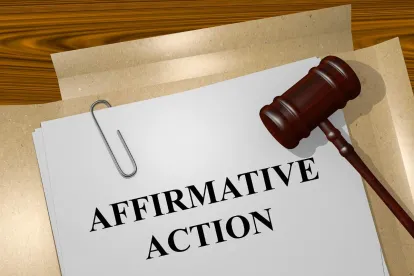The U.S. Supreme Court in Students for Fair Admissions, Inc. v. President and Fellows of Harvard College decided that the race-based admissions programs at Harvard College and the University of North Carolina (the “Schools”) violated the Equal Protection Clause of the Fourteenth Amendment. While the Court answered the question for publicly funded schools, it is an open question whether, and how, the Court’s decision will impact affirmative action and diversity programs for private employers, as discussed in more detail below.
Overview
The Fourteenth Amendment states, in relevant part, that no State shall “deny to any person . . . the equal protection of the laws.” Among other things, the clause protects people regardless of their race. A limited exception that permits race-based action by the government is permissible if such action can survive a rigorous standard known as “strict scrutiny.” Under that standard, race-based conduct is permissible only if the government can establish a “compelling government interest” and the race-based action is “narrowly tailored” to achieve that established interest.
The Supreme Court concluded that the Schools’ race-based admissions programs failed strict scrutiny. In support of their race-based admissions programs, the Schools asserted the following educational goals as their compelling interests:
-
Training future leaders in the public and private sectors/preparing engaged and productive citizens and leaders.
-
Preparing graduates to adapt to an increasingly pluralistic society/broadening and refining understanding.
-
Better educating students through diversity/enhancing appreciation, respect, and empathy, cross-racial understanding, and breaking down stereotypes/promoting the robust exchange of ideas.
-
Producing new knowledge stemming from diverse outlooks/fostering innovating and problem solving.
-
Preparing engaged and productive citizens and leaders.
The Court noted that although these goals were laudable, they were too amorphous to pass muster under the strict scrutiny standard. The Court recognized that a court would have no way to know whether leaders have been adequately trained; whether the exchange of ideas is sufficiently robust, or whether, and in what quantity, racial diversity leads to the development of new knowledge. In other words, the Court took issue with the fact that the asserted interests could not be measured in any meaningful, quantifiable way.
In addition, the Court found there was no meaningful connection between the Schools’ use of race in the admissions process and the claimed benefits. For example, the Court noted that while diversity may further the asserted interests, the Schools failed to establish that racial diversity would. The Court took particular issue with what it viewed as the overbroad and arbitrary nature of the Schools’ race considerations as they were underinclusive (for example, failing to distinguish between South Asians or East Asians, or define what Hispanic means, or account at all for Middle Eastern applicants). The Court reasoned that the overbroad, arbitrary, and underinclusive racial distinctions employed by the Schools undermine the Schools’ asserted interests—essentially noting that the Schools’ race-based admissions programs sought to “check the diversity box” rather than obtain a truly diverse (racially or otherwise) student body.
In addition to the School’s programs’ failure to survive strict scrutiny, the Court also recognized that the Schools’ race-based admissions processes promoted stereotyping, negatively impacted nonminority applicants, and, contrary to Court precedent, did not have a durational limit or any cognizable way in which to adopt a durational limit.
Supreme Court Precedent
The Court’s decision rested largely on two prior cases addressing race-based admission programs in higher education: Regents Univ. of Cal. v. Bakke, 438 U.S. 265 (1978) and Grutter v. Bollinger, 539 U.S. 306 (2003). As a guiding principle, the Court noted that the Equal Protection Clause of the Fourteenth Amendment bars admissions programs that use race as a stereotype or a negative.
In Bakke, while rejecting other asserted interests, the Court explained that obtaining the educational benefits associated with having a racially diverse student body was “a constitutionally permissible goal for an institution of higher education,” provided that certain guardrails were in place. This is despite the Court’s recognition that racial preferences cause serious problems of justice. The Court said that race only could operate as “a ‘plus’ in a particular applicant’s file” and the weight afforded to race must be “flexible enough to consider all pertinent elements of diversity in light of the particular qualifications of each applicant.”
In Grutter, the Court decided “student body diversity is a compelling state interest that can justify the use of race in university admissions,” provided that sufficient limitations were in place—notably, that under no circumstances would race-based admissions decisions continue indefinitely. The Court cautioned that, because the use of race was a deviation from the norm of equal treatment, race-based admissions programs must not result in “illegitimate . . . stereotyping,” must not “unduly harm nonminority applicants,” and must be “limited in time.”
The Court’s Additional Considerations
Of critical importance to the Court’s ruling was the fact that neither School’s race-based admissions program had an articulable end point. The Court noted that the Schools’ arguments to overcome the lack of a definite end point were, essentially, “trust us, we’ll know when we’re there.” Yet such arguments, the Court held, were insufficiently persuasive to offset the pernicious nature of racial classifications. Justices Thomas and Gorsuch, who joined the majority opinion, took additional issue with the Schools’ “trust us” arguments in separate concurrences, noting (1) their view of the Schools’ histories of harmful racial discrimination, and (2) that courts are not to defer to the morality of alleged discriminators.
Additionally, the Court took issue with the logical necessity that, in any instance when a limited number of positions are available, a race-based “plus factor” for applicants of a certain race is a negative for applicants who do not belong to the favored race. “How else but ‘negative’ can race be described if, in its absence, members of some racial groups would be admitted in greater numbers than they otherwise would have been?” In this, the Court recognized that equal protection is not achieved through the imposition of inequalities.
Impact on Private Employers
The Supreme Court’s recent decisions have no direct legal impact on private employers. The Court based its decision on the Equal Protection Clause of the Fourteenth Amendment, applicable to the Schools under Title VI, which does not intrinsically apply to private companies; it is Title VII and analogous state and local laws that apply to private employers (not Title VI) and prohibit private employers from discriminating against employees and applicants on the basis of race (and other protected characteristics). In employment, the law has always prohibited any consideration of race in decision-making, such as who to hire or who to promote, except in extremely narrow and limited situations but, even then, quotas and set-asides are strictly prohibited.
While not directly applicable, it is highly likely that the Court’s decision will spawn new challenges to private employer diversity and inclusion programs, and the Court’s rationale will be referenced as an indicator of how the Court will view such programs under Title VII. Even before the Court’s decision, the legal landscape around an employer’s use of affirmative action plans to aid in making employment decisions was murky. Generally a private employer’s affirmative action plan is permissible under Title VII in two scenarios: (1) if the plan is needed to remedy an employer’s past discrimination, and (2) if the plan is needed to prevent an employer from being found liable under Title VII’s disparate impact prohibitions (which operate to prohibit facially neutral policies that nevertheless disproportionately disadvantage certain groups).
Regarding the latter scenario, it is unlikely the Court’s ruling will have much if any impact. For an affirmative action plan to survive scrutiny on this basis, an employer must first prove a disparate impact case against itself: it must identify a specific policy, prove that such policy has a disparate impact on a certain group, and either show that the policy is not justified by business necessity or show that there is a viable alternative that both (a) accounts for the employer’s business necessity, and (b) has less of a disparate impact on the affected group. Then, the employer must prove how its affirmative action steps offset the disparate impact. There is nothing in the Court’s opinion that suggests an employer’s effort to remedy an ongoing Title VII violation would itself be a violation of Title VII.
However, there is language in the Court’s opinion that suggests an affirmative action plan implemented in the former scenario could be problematic, especially if it is not designed carefully. Indeed, a number of lower court decisions even before the Supreme Court’s recent ruling have struck down employer affirmative action programs. Permissible affirmative action programs are typically implemented to remedy past racial imbalances in an employer’s workforce overall, and are not tied to past discrimination against an identifiable employee or applicant. At the close of the Supreme Court’s recent opinion, it admonished Justice Sotomayor’s dissent wherein she proposed a world where schools consider race indirectly, through, for example, essays submitted alongside applications. The Court noted that such would nevertheless violate the Constitution, and clarified that admission decisions can rely on the content of application essays, but that such decisions must be based on an individual applicant’s character or experiences, and not based on the applicant’s race. Similarly, Justice Thomas, in his concurring opinion, recognized that “[w]hatever their skin color, today’s youth simply are not responsible for instituting the segregation of the 20th century, and they do not shoulder the moral debts of their ancestors.” Accordingly, challenges to affirmative action plans that attempt to remedy past discrimination generally, by using race in its decision-making may find purchase in the Court’s closing sentiments and Justice Thomas’s concurrence. Although a standard less exacting then “strict scrutiny” is used to evaluate discrimination claims under Title VII, the sentiment expressed by Members of the Court could make the judiciary increasingly skeptical of affirmative action programs that resemble those used by the Schools. In any event, the possibility of being able to continue to use affirmative action plans in the strict sense to increase diversity in an employer’s workforce is likely little comfort to private employers, as few will want to prove a discrimination case against themselves to justify a diversity program.
Additionally, employers’ diversity, equity, and inclusion (DEI) programs may be the subject of challenges based on the Supreme Court’s skepticism of the benefits of “racial” diversity, as opposed to diversity on less-pernicious characteristics. For example, DEI programs that seek to increase racial diversity based on broad racial definitions may be subject to challenges because of their overbreadth or purportedly arbitrary nature. And DEI programs that highlight racial diversity, rather than, for example, diversity based on socio-economic, ideological, or experiential characteristics may suffer challenges to their legitimacy in reliance on the Supreme Court’s implication that there may be no identifiable tether between “racial” diversity and the purported benefits of diversity as a concept.
Of course, to the extent private employers with affirmative action plans have contracts with government entities and/or receive government funding, affirmative action plans under the Office of Federal Contract Compliance Programs (“OFCCP”), require targeted diversity recruiting efforts, aimed at increasing the diversity of applicant pools, although this also does not permit race (or other protected traits) to be used in decision-making.
Practical Tips For Employers
The Court’s decision applies to affirmative action programs in the college setting and applies an analysis under the Equal Protection Clause that does not directly apply to private employers. The decision also deals with very different scenarios where colleges and universities directly used race as a criteria for admissions. As noted, this has generally never been permitted in the employment context and, as a result, the rules of the road for implementing DEI programs have not changed, although they may evolve through future legal challenges in light of the Supreme Court’s recent decisions. There are still countless ways that private employers can design and implement lawful DEI programs. Below are just a few examples employers may consider:
-
Reiterate D&I as a priority in meetings, conferences, and other communications.
-
Implement recruiting programs to diversify your talent pool.
-
Incentivize employees to refer diverse candidates for openings.
-
Support employee resource groups, mentoring programs, and leadership training.
-
Educate your managers and supervisors on unconscious bias.
-
Encourage diversity in suppliers and business partners.
-
Tie D&I efforts (not results) to managerial performance evaluations.
-
Under the privilege of working with counsel, monitor changes in workforce demographics and conduct pay audits.
-
Consider modifying the goal of DEI programs to seek diversity based on broader characteristics that do not involved protected classes, such as experiences, economic background, or worldview.
Conclusion
The Court’s decision is a landmark ruling that will alter the landscape of college and university admissions. And it will almost certainly spawn new challenges beyond the classroom and into the workplace.
However, the decision does not legally require private employers to make changes to their existing DEI programs if such practices comply with already-existing employment laws. Employers can still implement diversity and inclusion programs and promote diversity within their workplaces but, as has always been the case, employers should tread carefully in designing and implementing these programs. Employers would do well to engage counsel to review such programs and initiatives for possible concerns in light of the Court’s decision, as well as existing precedent in the employment context.






 />i
/>i

